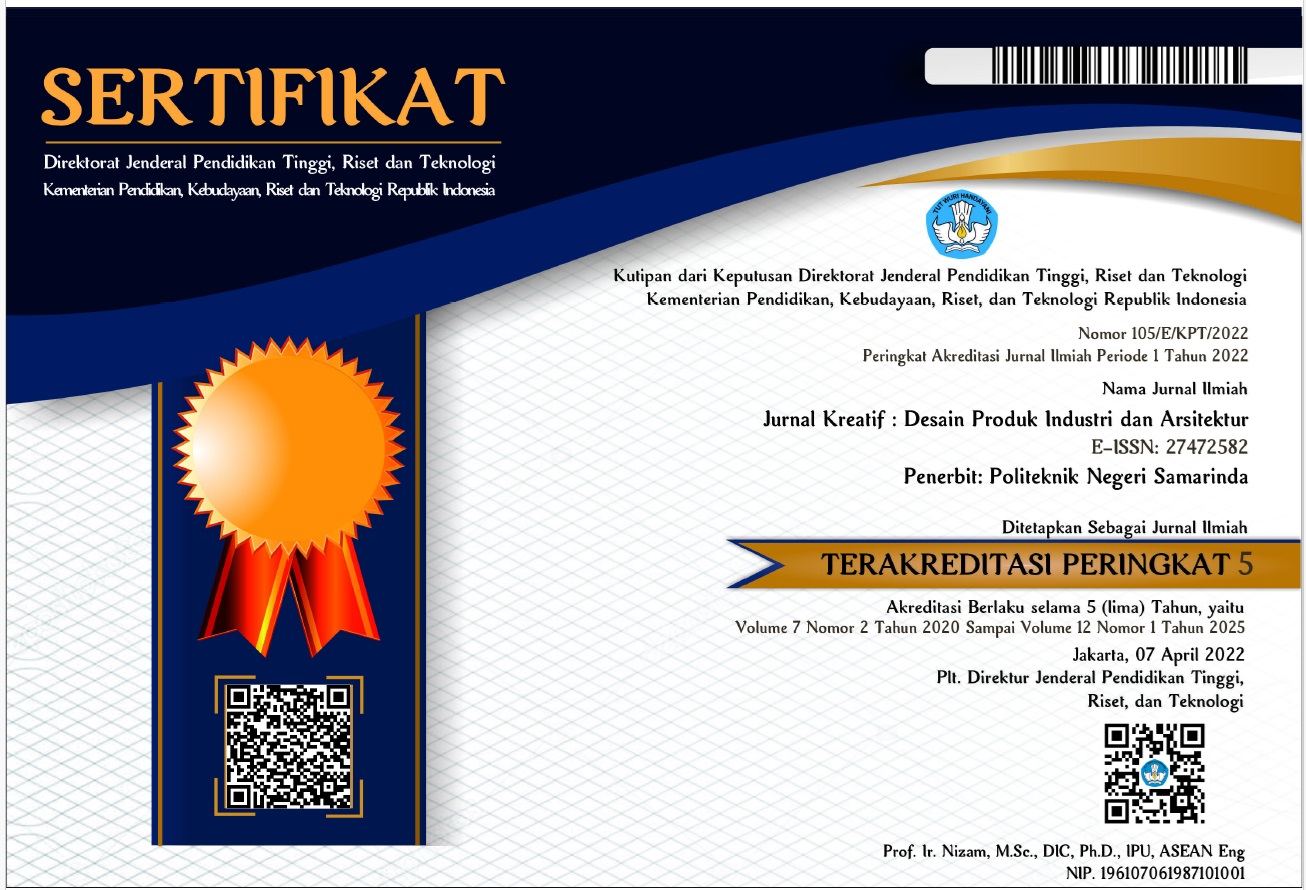DESAIN SEBAGAI PRODUK DAN PRAKTIK DAN RELASINYA DENGAN MEDIA DALAM INDONESIA 4.0
 Abstract views: 348
,
Abstract views: 348
,
 pdf downloads: 247
pdf downloads: 247
Abstract
ABSTRAK
Komunikasi sebagai sebuah proses penyampaian pesan dari komunikator (penyampai pesan) pada komunikan (penerima pesan) untuk mencapai kesamaan makna merupakan salah satu kebutuhan manusia sebagai makhluk sosial yang pada hakikatnya memerlukan berinteraksi antara satu dengan yang lainnya. Dalam proses komunikasi, interaksi ini dapat terjadi pada beragam tatanan. Beragam tatanan komunikasi sebagai bentuk interaksi manusia terdiri dari intrapersonal, interpersonal, kelompok kecil (small group), komunikasi publik, dan komunikasi massa. Klasifikasi tatanan komunikasi tersebut dilakukan berdasar pada jumlah orang yang terlibat dalam proses komunikasi; yang menempatkan komunikasi massa menjadi tatanan komunikasi yang melibatkan banyak orang, tersebar dan memiliki tingkat diferensiasi yang tinggi. Dalam komunikasi massa, secara konvensional, media yang lazim digunakan terklasifikasi dalam media cetak (surat kabar dan majalah) dan media elektronik (radio dan televisi). Artikel ini akan membahas kajian pustaka menggunakan Analisis Dokumentasi untuk mengidentifikasi potensi pengembangan Desain sebagai produk dan praktik dan relasinya dengan media di era Indonesia 4.0. Dalam hal ini, pendidikan tinggi desain berperan sebagai saluran pengayaan wawasan bagi mahasiswa untuk dapat memahami konsep yang kuat dan integratif dalam kaitannya menghadapi tuntutan kebutuhan Desain di Revolusi Industri 4.0.
Kata kunci: Produk Desain, Praktik Desain, Media dalam Desain, Indonesia 4.0
ABSTRACT
Communication as a process of delivering messages from the communicator (messenger) to the communicant (the recipient of the message) to achieve the same meaning is one of human needs as a social being which essentially requires interacting with one another. In the process of communication, this interaction can occur in a variety of settings. Various communication arrangements as a form of human interaction consist of intrapersonal, interpersonal, small groups (small groups), public communication, and mass communication. The classification of the communication order is carried out based on the number of people involved in the communication process; which puts mass communication into a communication system that involves many people, spreads and has a high degree of differentiation. In mass communication, conventionally, media commonly used are classified in print media (newspapers and magazines) and electronic media (radio and television). This article will discuss literature review using Documentation Analysis to identify potential development of Design as a product and practice and its relationship with the media in the Indonesian era 4.0. In this case, design higher education plays a role as an insight enrichment channel for students to be able to understand a strong and integrative concept in relation to the demands of design in the Industrial Revolution 4.0.
Keyword: Product Design, Design Practices, Media in Design, Indonesia 4.0
Downloads
References
Katz, H. (2003). The Media Handbook: A Complete Guide To Advertising, Media Selection, Planning, Research, and Buying, Second Edition. London: Lawrence Erlbaum Associates Publishers.
Laughey, D. (2007). Key Themes in Media Theory. New York: Open University Press. McLuhan, M. (1964). Understanding Media. New York: Gingko Press Inc. .
Ricoeur, P. (1983). Time and Narrative, vol. 1, translate K. Mclaughlin and D. Pellauer. Chicago: University of Chicago Press.
Uchjana, O. (2000). Ilmu, Teori dan Filsafat Komunikasi. Bandung: Citra Aditya Bakti.
Authors who publish with this journal agree to the following terms:
- Copyright on any article is retained by the author(s).
- The author grants the journal, right of first publication with the work simultaneously licensed under a Creative Commons Attribution License that allows others to share the work with an acknowledgment of the work’s authorship and initial publication in this journal.
- Authors are able to enter into separate, additional contractual arrangements for the non-exclusive distribution of the journal’s published version of the work (e.g., post it to an institutional repository or publish it in a book), with an acknowledgment of its initial publication in this journal.
- Authors are permitted and encouraged to post their work online (e.g., in institutional repositories or on their website) prior to and during the submission process, as it can lead to productive exchanges, as well as earlier and greater citation of published work.
- The article and any associated published material is distributed under the Creative Commons Attribution-ShareAlike 4.0 International License













